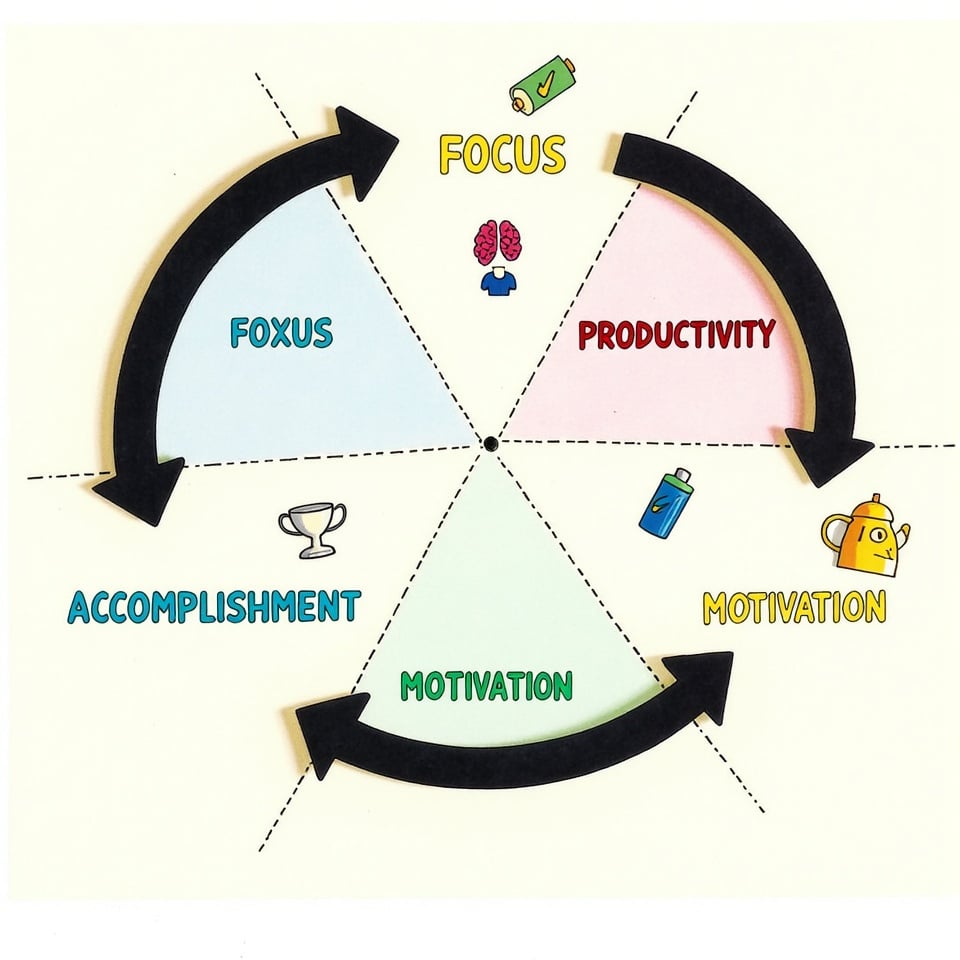Struggling to stay on top of your daily tasks?
The ALPEN method is a proven time management technique that helps you plan smarter, reduce stress, and get more done—without burning out.
Created by Lothar J. Seiwert, this simple five-step system is used across Germany and beyond to boost productivity and bring structure to chaotic workdays.
In this guide, you’ll learn exactly how the ALPEN method works—and how to start using it today.
What ALPEN Stands for in Time Management
The ALPEN method is a simple but powerful time management technique developed by Lothar J. Seiwert, a German economist, professor, and one of Europe’s top time management experts.
If you’ve ever felt overwhelmed by your to-do list or unsure what to tackle first, this technique might just change how you plan your day.
The name ALPEN isn’t just a catchy word that sounds like a Swiss hiking trip—it’s actually a German acronym that breaks down into five easy steps for organizing your daily tasks. Here’s what each letter stands for:
- A – Aufgaben notieren → Write down all your Activities for the day
- L – Länge schätzen → Estimate the Length of time each task will take
- P – Pufferzeiten einplanen → Add Buffer time for the unexpected
- E – Entscheidungen treffen → Establish priorities for what matters most
- N – Nachkontrolle → Note level of success and reflect afterward
That’s it—five steps. No apps, no fancy tools. Just a notebook (yes, really) and your brain.
It’s a systematic approach to planning that helps individuals structure their work, prioritize tasks effectively, and regain control over their schedules.
It’s especially popular in Germany and has been taught in places like Vienna Student Counselling and time management seminars across Europe.
Some even compare it to other classic frameworks like the Pomodoro Technique, Eisenhower Matrix, or ABC method, but what makes ALPEN stand out is how simple and human it feels.
You’re not just cramming more work into your day. You’re building in space to breathe, reflect, and plan better for tomorrow.
| ALPEN Step | Benefits | Challenge Solved |
|---|---|---|
| A – Activities | Clarity through task listing | Eliminates forgetfulness |
| L – Length | More accurate time use | Prevents overbooking |
| P – Buffer Time | Flexibility in your schedule | Handles unexpected delays |
| E – Establish Priorities | Focus on what matters most | Reduces decision fatigue |
| N – Note Success | Continuous daily improvement | Stops repeated mistakes |
Applying the ALPEN Method to Daily Planning
So, how do you actually use the ALPEN method in real life? Good news—it’s not complicated.
In fact, once you try it a few times, it becomes second nature.
Whether you’re a student juggling deadlines, a busy professional drowning in meetings, or just someone trying to stop forgetting birthdays and grocery lists, this method works.
The goal is simple: structure your day, reduce stress, and stay productive without burnout.
Let’s break down each step of the ALPEN method and see how you can apply it to your daily planning routine—starting with the first (and often most overlooked) part: listing your tasks.
Step 1: Define All Tasks for the Day
Start your day by dumping everything in your head onto paper—or a digital note, if that’s more your vibe. This includes work tasks, personal errands, meetings, even that call you’ve been avoiding. Don’t filter. Just get it all down.
Think of it as your brain’s to-do list.
The ALPEN method isn’t about remembering—it’s about organizing.
If it matters, it belongs here. Even small things like “reply to client email” or “refill water bottle” count. It helps you get clarity fast.
This step ties directly into the “A” in ALPEN: Activities. It’s your launchpad for everything else.
Step 2: Estimate Time for Each Task
Now look at your list and guess how long each task will take.
Don’t stress about being perfect—just estimate.
Is that report a 30-minute job? Will the meeting actually end in 45 minutes or drag on?
Be honest with yourself. If you underestimate everything, you’ll run into burnout. And no one wants to sprint all day without a break.
This is where the “L” for Length comes in.
You’re training your brain to respect time as a resource. Once you do this regularly, your guesses get better. It’s like mental weightlifting for time awareness.
Step 3: Plan Buffer Time Between Activities
Here’s the step most people skip—and regret later. Life throws curveballs. A quick task turns into a mess. You get distracted. Someone calls. Buffer time is your safety net.
Plan 20%–30% of your total day as “flex time.” This is your breathing space between tasks.
Maybe 10 minutes after a meeting to decompress. Maybe an empty 30-minute block in the afternoon just in case.
This is the “P” for Pufferzeiten (buffer time). It helps you manage unexpected delays without spiraling into stress. It’s like giving your schedule a hug.
Step 4: Make Informed Prioritization Decisions
Not every task deserves your attention today. Look at your list and mark what truly matters.
Focus on urgency and importance—like the Eisenhower Matrix, but lighter.
Ask:
- What has a deadline?
- What moves me closer to my goals?
- What will cause chaos if ignored?
You’re working the “E” step now: Entscheidungen treffen—make decisions. Some use the ABC method here (A = must-do, B = should-do, C = nice-to-do).
This step is about smart prioritization, not doing everything. Be ruthless. Your sanity will thank you.
Step 5: Review and Adjust Your Daily Plan
You made a plan. Great. Now check in with it—what worked, what didn’t?
Did you overestimate how long something would take? Did your buffer time save the day?
At the end of your day, take 5 minutes to reflect.
This is “N” for Nachkontrolle—review and control. It’s how you improve your future planning.
Write down what went well, and what to tweak. Maybe you need more buffer. Maybe mornings are better for deep work. Over time, this habit turns your daily chaos into a predictable workflow.
This isn’t about perfection. It’s about progress with less stress. Keep adjusting, and you’ll start to feel in control—even on the busiest days.
Key Benefits of the ALPEN Method
The ALPEN method isn’t just about planning your day—it’s about changing the way you think about time.
By following this five-step routine, you’re not only organizing tasks, you’re building habits that lead to more clarity, control, and calm in your workflow.
Here’s what makes the ALPEN method stand out as a time management tool that actually works:
- The ALPEN method increases productivity by helping you focus only on essential, high-impact tasks.
- It reduces stress by including buffer time to handle unexpected delays or interruptions.
- It improves prioritization through a simple system that makes it easier to decide what matters most.
- It encourages daily reflection so you can learn from what worked and what didn’t.
- It’s flexible and doesn’t require any special tools—just a notebook or any digital note-taking app.
- It supports work-life balance by ensuring your schedule isn’t overloaded or packed too tightly.
- It integrates well with other time management techniques like the Pomodoro Technique or Eisenhower Matrix.
- It helps you become more aware of how long tasks really take, making time planning more accurate.
- It adapts to different lifestyles and workloads, whether you’re a student, freelancer, or team leader.
ALPEN Method Compared to Other Planning Techniques
Time management isn’t one-size-fits-all. There are dozens of planning techniques out there—some more complex, others more rigid. What makes the ALPEN method unique is how simple, realistic, and adaptable it is, especially for daily use.
Let’s look at how it compares to a few popular techniques:
- Pomodoro Technique focuses on working in 25-minute time blocks with short breaks. It’s great for maintaining focus, but it doesn’t help you decide what to work on. ALPEN fills that gap by helping you prioritize first.
- Eisenhower Matrix sorts tasks by urgency and importance, which is powerful for decision-making. However, it doesn’t include time estimates or review. ALPEN includes both, making it more practical for daily execution.
- The ABC Method helps prioritize by labeling tasks as A (must-do), B (should-do), or C (nice-to-do). ALPEN can incorporate this step within its prioritization phase, but goes further by factoring in time and flexibility.
- DMAIC (Define, Measure, Analyze, Improve, Control) is used in process improvement, not personal scheduling. ALPEN is more accessible for day-to-day planning and doesn’t require a data-driven mindset to be effective.
In short, ALPEN doesn’t compete—it complements. It combines planning, prioritizing, timing, and reflecting in a lightweight, no-friction way. Where others focus on structure or focus alone, ALPEN brings a full-cycle system you can start using today—no training, no tools, just results.
Mistakes to Avoid When Using the ALPEN Method
The ALPEN method is simple—but that doesn’t mean people always use it right.
Small missteps can quietly undo its effectiveness.
If you’re just starting out or even if you’ve been using it a while, here are some common mistakes to watch for:
- Skipping the task list and planning from memory defeats the purpose of the method. Writing things down is non-negotiable—it’s what gives the method its structure.
- Underestimating how long tasks will take leads to frustration and spillover. Be generous with your time estimates, especially early on. Realistic timing beats optimism.
- Forgetting to include buffer time makes your day brittle. Unexpected delays will happen. If you don’t build in breathing room, you’ll constantly feel behind.
- Treating everything as equally important weakens prioritization. Use a framework (like the ABC method) to decide what truly deserves your focus.
- Ignoring the review step at the end of the day means you’ll keep repeating the same planning mistakes. Reflection is what turns a good plan into a better one tomorrow.
- Overloading your schedule with too many tasks creates a false sense of productivity. ALPEN isn’t about doing more—it’s about doing what matters, well.
- Using the method inconsistently makes it hard to form habits. Use it daily—even if your list is short. Consistency compounds clarity.
Avoiding these mistakes keeps the ALPEN method working with you, not against you. The goal isn’t perfection—it’s progress, with less stress.
Who Can Benefit Most from the ALPEN Approach
The ALPEN method isn’t designed for a specific job or lifestyle—it’s designed for anyone who feels like time is slipping through their fingers.
Whether you’re managing deadlines, meetings, or just everyday chaos, this technique can help you get ahead of the day instead of chasing it.
Here’s who can benefit the most:
- Busy professionals juggling meetings, emails, and shifting priorities can use ALPEN to structure their day and protect focus time.
- Students (especially at university level) often face unstructured schedules. ALPEN helps them manage coursework, assignments, and study blocks effectively.
- Freelancers and entrepreneurs need to wear multiple hats. The method brings clarity to chaotic to-do lists and ensures no task slips through the cracks.
- Overwhelmed parents or caregivers who feel like there’s never enough time can use ALPEN to plan smarter and reduce daily stress.
- Anyone struggling with procrastination can break the cycle by listing tasks, estimating effort, and creating momentum through small wins.
- Teams or managers can even adapt the method to daily stand-ups or planning meetings to keep group workflows on track.
At its core, ALPEN is a tool for better organization, less stress, and smarter decisions—and that’s something just about everyone can use.
Final Thoughts on Implementing the ALPEN Method
Implementing the ALPEN method isn’t about doing more—it’s about managing what matters with clarity and control.
It gives you a clear framework to structure your day without overcomplicating the process.
Stick to the steps, stay consistent, and let the method work for you.
Small daily improvements add up. The sooner you start, the faster you’ll see results.







